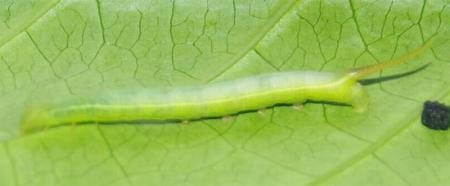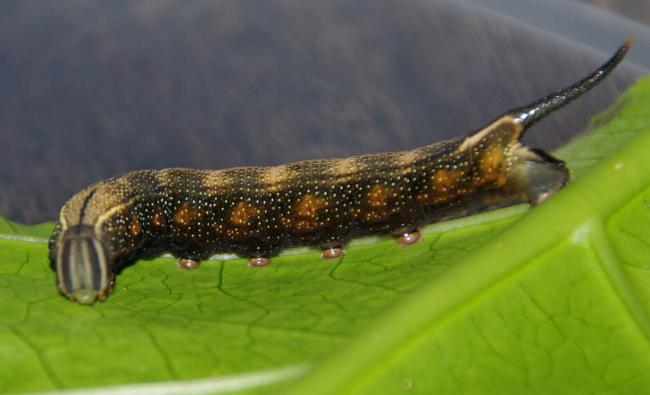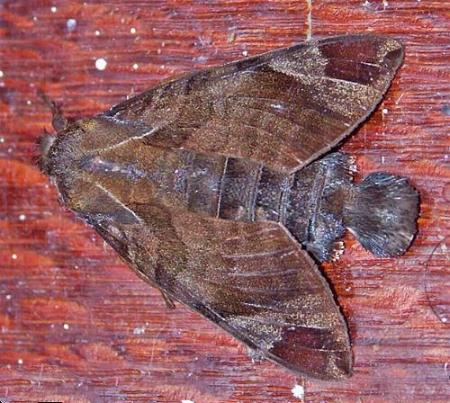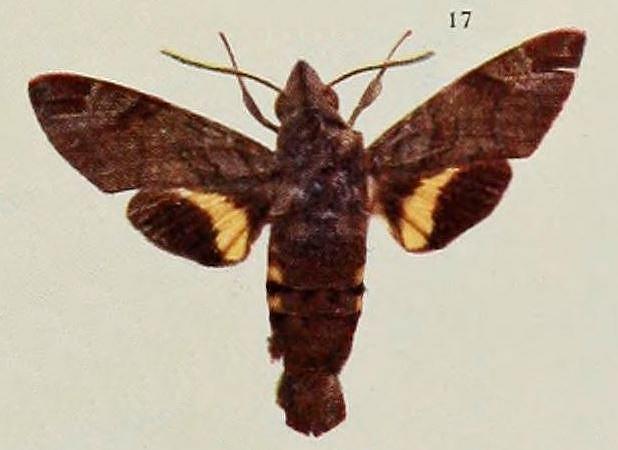
| MACROGLOSSINAE, SPHINGIDAE, BOMBYCOIDEA | (donherbisonevans@yahoo.com) and Stella Crossley |

early instar
(Photo: courtesy of
Carol and Trevor Deane,
Whyanbeel, Queensland)

| MACROGLOSSINAE, SPHINGIDAE, BOMBYCOIDEA | (donherbisonevans@yahoo.com) and Stella Crossley |

early instar
(Photo: courtesy of
Carol and Trevor Deane,
Whyanbeel, Queensland)
Early instars of the Caterpillars of this species are green with a green tail spike. Penultimate instars have four pale lines along the back, and a dark brown tail spike with a white tip. The last instar is brown with dark speckles forming diagonal stripes along the sides, a pale stripe each side of the head extending to broken dark lines along the back and along each side, and a dark tail spike that lies backwards with a forward curving white tip. Late instars can also develop orange spots along the sides.

The caterpillars have been found feeding on plants in RUBIACEAE, including
The caterpillars grow to a length of about 5 cms. The caterpillars pupate in a cocoon amongst surface debris. The pupa is brown with dark markings including a dorsal line on the thorax, and spots on the spiracles. The pupa is unusual in having a narrow collar to the developing head. The length of the pupa is about 4 cms.

The adult moths are brown with a vague pale band across the wingtip of each forewing, and a broad yellow band across each hindwing. The moths have a wingspan of about 6 cms.
The moths have been noted for flying in the daytime, and also being pollinators of the River Cherry ( Syzygium tierneyanum ).

The species is found in
and also in Australia in
Further reading :
Maxwell S. Moulds, James P. Tuttle and David A. Lane.
Hawkmoths of Australia,
Monographs on Australian Lepidoptera Series, Volume 13 (2020),
pp. 185-186, Plates 44, 76, 89.
Buck Richardson,
Tropical Queensland Wildlife from Dusk to Dawn Science and Art,
LeapFrogOz, Kuranda, 2015, p. 202.
Lionel Walter Rothschild & Karl Jordan,
A revision of the Lepidopterous family Sphingidae,
Novitates Zoologicae,
Volume 9 Supplement, Part 1 (1903), p. 652, No. 593, and also
Plate 4, fig. 17.
 caterpillar |  butterflies |  Lepidoptera |  moths |  caterpillar |
(updated 12 November 2011, 12 July 2019, 7 September 2020)